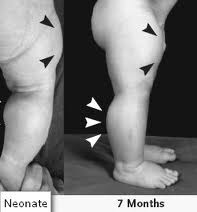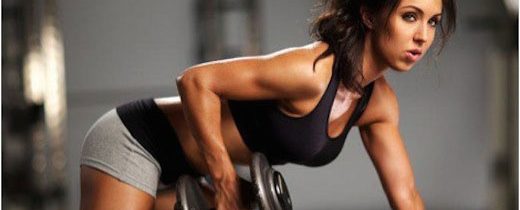Why You Should be Lifting Weights and Why you Should not be worried about “Getting Too Big”
Guest Post by George Ironthumb
There’s really no question about it – we love to lift, we love to sweat and kick ass in the weight room – in other words “we love to BUILD MUSCLE”.
But what most people and laymen don’t know is that muscle building and lifting are not just confined and reserved to those dedicated gymrats who love to pose and flex their biceps in front of the mirror. Most laymen who obviously could use some training sessions in the weight room are scared of touching the iron and gaining muscle because of irrational fears that they will suddenly wake up one day looking like Arnold Schwarzenegger during his prime (how I wish that was true!!). So in this post I will tell you exactly why you should be lifting weights and why you should throw away all your fears and misconceptions.
YOU WILL NEVER GET TOO BIG!
There was this guy who chatted with me earlier today; he said he wants to lose weight but he kept on negating each and every one of my advise telling me “I’ll get too big” – now tell me how am I supposed to not be pissed off? If you gave me a penny for every person who approached me like that, then you would run out of money real FAST!!
Now how I wish this was a real issue believe me! Building and maintaining muscle mass is very difficult! Do you think that Arnold, Ronnie Coleman, and even those female bodybuilders just lifted weights and woke up one day to look like mass monsters? Of course not – you sillyt!!
Building that amount of muscle takes dedication and medical intervention in form of testosterone to be exact. Thousands of dollars need to be spent on supplements, coaching, and diet! They also need to plan their rest periods, their diet, their hormonal supplementation carefully and most of the time it really isn’t possible to recreate their results without proper genetics and if you cannot focus 100% of your time on building muscle.
That means for those athletes who look like hulk, building muscle is their full time job which is why they achieved those results in the first place. So if you have a day job and are lifting intensely 1 or 3 times a week you will have greater chances of winning the lottery than achieving their same level of muscle mass even if you actually invest in eating clean.
This fear actually comes off as an insult to those lifters who are serious in gaining muscle – people just don’t know how hard one needs to work for each and every pound of lean mass to be added to that D.A.M.N scale.

Another scientific fact is that the body has a biological mechanism to control muscle growth – its through a molecule called Myostatin. As I have written before, myostatins are the molecules that control muscle growth and some individuals (and animals) are naturally born with deficient or outright no myostatin at all (or were genetically mutated – like lab rats) and thus they become living beasts who gain muscle easily like these examples below:
So far we have learned that without (or reduced)myostatins, individuals and animals experience unstoppable muscle growth and therefore some of the IFBB professionals that you see on Mr. Olympia may as well be naturally Myostatin-deficient and or naturally have high Testosterone levels and have very compatible bone structure (plus are on thousands of dollars-worth of hormonal cycle).
But why exactly does the body want to minimize of suppress muscle-growth?
It doesn’t make sense; wouldn’t it be cool to become as muscular as we can be? Wouldn’t we have greater odds for survival in the wild only if humans had more muscle mass? Perhaps we could have even wrestled a bear! Well sadly no, no and NO! Muscles are actually calorie-voracious tenants and extra muscle mass will be considered by the body as “free-loaders”. So Myostatin is a form of negative feedback to muscle growth but in fact exercising actually decreases Myostatin levels (since the body detects that these fat-free mass aren’t so useless after all). But that doesn’t mean that gaining muscle will be all like walking in the park – as we said Myostatin only decreases, it doesn’t go away completely!

Which leads us to:
Muscles Help Fight Obesity and Diabetes:
So your muscles are contractile tissues and it is also considered as a secretory organ. Knowing that fact it should come as to no surprise that muscles come with their own energy requirement for maintenance – which is why it is regulated by the body (myostatin is one form of that). Simply put, if the body does not “nerf” muscular gain; it might end up being too inefficient as is another tissue that consumes resources. Much like a business owner carefully auditing manpower needed to run his enterprise – as too much manpower recruited will only add unneeded people on payroll. As a rule, any rational thinking enterprise only will keep the bare minimum of manpower that is required to run their operations and the same goes with your body and muscle mass.
Skeletal muscle metabolism is a major determinant of resting energy expenditure
Just to prove our point, let us examine a study conducted by F Zurlo and his team:
Energy expenditure varies among people, independent of body size and composition, and persons with a “low” metabolic rate seem to be at higher risk of gaining weight. To assess the importance of skeletal muscle metabolism as a determinant of metabolic rate, 24-h energy expenditure, basal metabolic rate (BMR), and sleeping metabolic rate (SMR) were measured by indirect calorimetry in 14 subjects (7 males, 7 females; 30 +/- 6 yr [mean +/- SD]; 79.1 +/- 17.3 kg; 22 +/- 7% body fat), and compared to forearm oxygen uptake. Values of energy expenditure were adjusted for individual differences in fat-free mass, fat mass, age, and sex. Adjusted BMR and SMR, expressed as deviations from predicted values, correlated with forearm resting oxygen uptake (ml O2/liter forearm) (r = 0.72, P less than 0.005 and r = 0.53, P = 0.05, respectively). These findings suggest that differences in resting muscle metabolism account for part of the variance in metabolic rate among individuals and may play a role in the pathogenesis of obesity.
So they found out that indeed muscle mass does affect resting metabolism. Although you might have been seeing figure like “13 calories/pound of muscle”, none of these figures have actually been found to be true. But even if this figure is too high to be true, there is no denying the fact that carrying more muscle is beneficial for shredding fat and maintaining a leaner body.
In addition to Muscle’s resting metabolic consumption; there is also the factor of constant rate of protein turnover. After a serious exercise session your recovering muscles will eat up a lot of calories. Therefore the person with more percentage of muscle will end up consuming more calories as their muscles recover.
But case in point, calories consumed is not the only way muscles can aid in fat loss. As it turns out, the presence of muscles increase and improve metabolism in a number of ways:
Increasing muscle mass to improve metabolism
Skeletal muscle insulin resistance is a predictor of the development of type 2 diabetes and maintenance of adequate muscle glucose disposal in muscle may help to prevent diabetes. Lipodystrophy is a type of diabetes caused by a reduction of white adipose tissue and the adipokine leptin. Lipidemia, insulin resistance and hyperphagia develop as a consequence. In a recent study, we showed that increasing skeletal muscle mass by inhibiting signaling of myostatin, a transforming growth factor β (TGFβ) family member that negatively regulates muscle growth, prevents the development of diabetes in a mouse model of lipodystrophy. Muscle-specific myostatin inhibition also prevented hyperphagia suggesting muscle may regulate food intake. Here we discuss these results in the context of strategies to increase muscle insulin sensitivity as well as new findings about the effects of myostatin and other TGFβ family members on similar metabolic processes (link to study)
So here they found out that Muscle mass actually protected against diabetes by means of increasing insulin sensitivity. In humans, lean mass is positively associated with reduced incidence of insulin resistance or the metabolic syndrome (research), a group of risk factors for cardiovascular disease and Type 2DM (type 2 Diabetes Mellitus) that includes elevated fasting glucose and triglyceride levels, hypertension, obesity and reduced HDL. Like endurance exercise, resistance exercise is also associated with improvements in glucose metabolism and both are now recommended for T2DM patients.
Myostatin Inhibition Prevents Diabetes and Hyperphagia in a Mouse Model of Lipodystrophy (link)
What’s funny is that they expected the muscular mice they experimented on to “overfeed” – since it makes sense since they have more lean mass; but it turns out that they actually expressed NORMAL eating pattern. For some odd reason there must have been a chemical secreted by the muscle cells that signal “satiety” to the brain. I believe this might be a negative response – maybe a mechanism by the body to stop further muscle gain and therefore the body in itself controls the intake of food – but I digress.
Will we need to look like bodybuilders?
Well so far we have proven that muscle does indeed help (a lot) in fat loss and in achieving a healthier metabolism. We also learned that muscle mass decreases significantly our risk for contracting several metabolic diseases such as diabetes mellitus (type2 – the type that you are not born with). Well you might be thinking: to be able to reap all these benefits; do we need to become as big as a bodybuilder?
Well, not so fast there. No you don’t need to look like a bodybuilder and I don’t believe one would achieve those same results naturally anyway. And like what we have discussed earlier it will be very difficult to gain that kind of muscle gain.
You can’t ACCIDENTALLY gain that much MUSCLE!!!
When you gain muscle, you actually will more or less still look “normal” especially if you were fat to begin with. You will notice some tone in your muscles and that’s tremendous gains already. If you ever see models who are “fit” they actually have more muscle mass percentage than the regular sedentary Joe.
Imagine a fat person (no offense) saying “I don’t want to look like a bodybuilder yuck!” – Well darling, I guess you would look better as a bodybuilder than how you are now, don’t you think?
Drop the PINK dumbbells!!
Our invitation to you oh readers, now is to take lifting and muscle building more seriously. I often see women going to the gym but settle for those pink dumbbells even if they can do with a lot more weights! Seriously once you can do 12 and more with a specific weight with a specific move, that’s the time you graduate to a heavier weight! That’s the rule of the thumb for most male lifters (who also want to lose fat) and being a woman doesn’t exempt you from that! I often hear women say “but I don’t wanna be big I just want to lose weight” – well that’s exactly the point; you ain’t gonna get no fat loss if you won’t “tone” or develop your muscle – and you ain’t never gonna tone your muscle settling for a puny weight!
Progress and overload!!
Like what you should be doing! Give your muscles some love! And don’t worry about getting too “BIG” (especially if you’re female) – you won’t! If you’re female and you want to get in the same level of physique as those badass bodybuilder women, you would need a good testosterone supplementation program i.e. ROIDS!! I got girls in our weight room who can deadlift 200lbs and they’re still as sexy as hell! Needless to say that they don’t look like bodybuilders and the best part is they actually eat a lot without getting fat! Because they have good muscle tone!
So I hope this clears out the inhibitions to lift in fear of getting “too big”. Now if you got into your senses already and wish to take lifting seriously (for your own sake) then worry not I have several for you. If you wish to check out more of my work then please subscribe and get a free eBook with it! You can also check out my book if you want to get your fitness to a whole new level– it’s live on Amazon. You can also find me on Twitter (@Aboutlifting) same handle for my fan page on Facebook.
I would like to thank Dr. Lori Shemek for this opportunity to post in her website! I sure hope this post has helped enlighten a lot of you ladies and guys about the importance of lifting. If you have been reading a lot of Dr. Lori’s work, I am sure you are a fan of health. Then I think Doc will agree with me here that weight training is crucial for your quest for health and longevity. Cheers and God bless!!

About the Author:
For this Author there are only 3 things that make life worth living:
1) God, 2) Family, and 3) LIFTING WEIGHTS! He doesn’t “work out”; he TRAINS – hard and smart, using the most basic principles that seem to simplify the complicated. He knows that every “great” and “expensive” program is just a byproduct of the most important fundamentals of science and conditioning which he knows by heart and he lives to share with you all. As a Registered Nurse George has used more of what he learned in the field of Medical Science to help Gym Rats such as him achieving results than hospital patients. George is not a green-thumb and cannot even grow a weed – but he’s an Ironthumb who can help you GROW using Steel, IRON, and GUTS!





